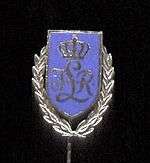Badonviller Marsch
The "Badonviller-Marsch" (AM II, 256) is a Bavarian military march by composer Georg Fürst (1870–1936). After 1934, with its name Germanized to "Badenweiler Marsch" by the Nazis, it was used as the official march of Hitler in his role as Führer, to signal his arrival and therefore personal presence at public events.
| "Badonviller-Marsch" | |
|---|---|
| March by Georg Fürst | |
| Catalogue | AM II, 256 |
| Composed | c. 1914 |
| Audio sample | |
United States Marine Band performing the march
| |
History

Fürst composed this tune as the Badonviller-Marsch for the Royal Bavarian Infantry Guard Regiment. The title refers to fighting on 12 August 1914 near Badonviller (the original German name of the town was Badenweiler until annexed by France in 1766) as part of Lorraine, where the Royal Bavarian Infantry Guard Regiment (Königlich Bayerisches Infanterie-Leib-Regiment) achieved a first victory against the French at the beginning of the First World War. The composer's lively two-tone entrance motif was by some accounts inspired by the duotonic sirens of field ambulances, with which the wounded were removed. This march is included in the Heeresmarsch collection as HM II, 256.
After the death of Paul Hindenburg 1934, the march was used as a personal "Führer-Marsch" for Hitler alongside his possession of a personalised standard. As mentioned in Henry Picker's edition of Hitler's so-called "Table Talks", the march's role was to evoke the presence of Hitler as the leader of the Nazi Party and head of the German state.[1] Hitler claimed to be the sole source of power in Germany, similar to a Roman emperor. The march had a similar formal role as the Pontifical Anthem for the Pope as the embodiment of the Holy See.[2] Features from the National Socialist period or newsreels (e.g. "Deutsche Wochenschau", etc.) had the march being pasted into the audio track as background music when appearances of Hitler were shown. However, the march was already often in use before the Nazis came to power. The German police order Polizeiverordnung gegen den Mißbrauch des Badenweiler Marsches of 17 May 1939 ordered that the Badenviller only be played when Hitler was present.[3] The Germanized name Badenweiler-Marsch was introduced by the National Socialists. [4] It is subtitled as "The Führer's favourite march" in Triumph of the Will during the massive street parade through Nuremberg at the end of which the Leibstandarte SS Adolf Hitler marches off.[5] Lyrics were subsequently added to the march by the German poet Oskar Sauer-Homburg after Hitler's rise to power in 1933.[6]
The march is often reported as Hitler's favourite.[7][8] However, Hitler is quoted in Traudl Junge's autobiography, Until the Final Hour, as denying that it was his favourite march, and was merely misconstrued as such because of a favourable remark he had made about it.
In 1956, the first director of the Bundeswehr Militärmusikdienst, Friedrich Deisenroth, provided a „Fachdienstliche Anweisung“ (specific service directive) for the German Bundeswehr orchestra, to avoid playing the march except in concerts with distinctive, educational reference to the historical background. The official title is still Badonviller-Marsch, using the Alsatian and French form of the name. Its connection with the Third Reich damaged the reputation of Georg Fürst as a composer in post-war Germany. A revival of his other compositions took place in the 1990s, however. Orchestras of the Communist National People's Army started to adapt a broader range of traditional marches as early as in the 1960s, but Badonviller was left out, as were similarly the Fridericus-Rex-Grenadiermarsch and Preußens Gloria. [9]
In popular culture
- Utz Utermann, a leading Nazi journalist and later publisher of the works of UFO fringe theorist Erich von Däniken, published a book named Badenweiler Marsch in postwar Germany, using the pseudonyme Mathias Racker. [10]
- Scenes in Valkyrie include the Badenweiler Marsch being played as background music to Radio Berlin announcements about the status of Adolf Hitler.
- In the movie about Max Manus, German infantrymen play this march as they walk down 'Karl Johans Gate' in Oslo.
- The march is used in the 1979 film The Tin Drum, and in the 1996 film The Ogre.
- Today, it is used by the Chilean Navy, under the name "Naval".
See also
References and notes
- Hitlers Tischgespräche im Führerhauptquartier Henry Picker, 05.03.2014
- Die Aussenpolitik des Dritten Reiches 1933-1939, Rainer F. Schmidt, Klett-Cotta, 2002
- Polizeiverordnung gegen den Mißbrauch des Badenweiler Marsches May 17th 1939 Reichsgesetzblatt I p. 921.
- Musik, Macht, Staat: kulturelle, soziale und politische Wandlungsprozesse in der Moderne, Sabine Mecking, Yvonne Wasserloos, V&R unipress GmbH, 2012
- Triumph of the Will (Universum Film AG, 1935), English subtitles.
- "Catalog of Copyright Entries: Musical compositions". 1935.
- Badenweiler March. Time, 1939-06-05 (viewed 2008-10-18).
- Happy Hitler. Time, 1940-07-15 (viewed 2008-10-26).
- Ulbrichts Soldaten: Die Nationale Volksarmee 1956 bis 1971, Rüdiger WenzkeCh. Links Verlag, 16.01.2013
- Review in Biblos, Band 31, Phoibos-Verlag, 1982